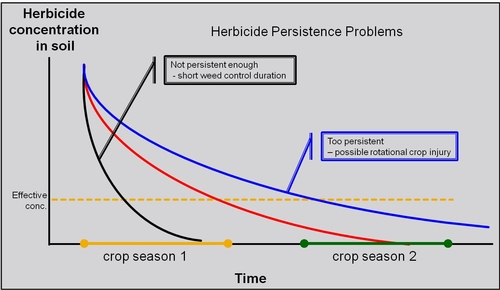This week I received an email request for information on the soil concentration of herbicide necessary to have a phytotoxic effect. This is a simple-sounding question and I was able to confidently say “Well, that depends….”.
Of course this isn’t a simple question at all because of the great differences among herbicides, soil types, environments, and in plant susceptibility not to mention complicated interactions among the factors. As an example, in the herbicide treatment table IPM guidelines for Pear (http://www.ipm.ucdavis.edu/PMG/r603700311.html) it is obvious that herbicides can be active at quite different concentrations. In this table, there is up to a 200-fold difference in application rates between rimsulfuron (0.03 lb ai/A) and diclobenil or oryzalin (4-6 lb ai/A) which can give between 4 and 10 months of residual control of various weeds.
When thinking about herbicide concentrations in soil or when interpreting lab results it is useful to be able to estimate the likely starting concentration using a couple “rules of thumb”.
- One of these is the estimated weight of 2 million lbs for a 6-inch acre furrow slice (a furrow slice is the depth of tillage for a moldboard plow that “slices” and inverts a strip of soil with each pass. One acre furrow slice is 43,560 ft2 by 6 inches deep).
- Given this estimate, if we applied 4 lb active ingredient per acre and then incorporated it 3 inches deep (1 million lbs), we would have started with approximately 4 parts per million (4 lb ai in 1,000,000 lb soil).
- We can get a little closer to a given situation if we know the actual measured bulk density of soil in the field. Most agricultural soils have a bulk density of 1.2 to about 1.7 g/cm3 (75 to 106 lb/ft3). Soil surveys or tools like this one: http://www.bio-formllc.com/obt-soilbulkdensities.html also can be used to get a closer estimate.
- If we have a sandy loam soil with a bulk density of 100 lb/ft3 (1600 kg/m3 which is the same as 1.6 g/cm3) and apply the same 4 lb ai/A herbicide and incorporate to 3 inches (0.25 ft) we could estimate an initial herbicide concentration of 3.67 ppm.
A couple of important reminders about estimating herbicide concentrations this way:
This is an ESTIMATE of INITIAL concentration and really is a “ballpark” figure. Actual concentrations will be affected by rates of application, incorporation (dilution) depth, and time since the herbicide was applied.
- The effect of application rate should be obvious – if all other factors are the same, twice as much herbicide will result in twice the initial concentration.
- If the herbicide is incorporated more deeply due to tillage or movement with water the concentration will be reduced or diluted. This can contribute to failures of some herbicides. Similarly, if the herbicide is incorporated more shallowly or not at all, the concentration will be relatively higher (less dilution).
- Finally, the time since application will affect the concentration of herbicides in soil because of degradation and other dissipation processes.

With soil residual herbicides, the initial concentration is usually considerably higher than the amount necessary for herbicidal activity. This is the reason for the residual activity – the concentration remains above the threshold level for a period of time even as degradation processes begin (see the example figure). I put this figure together for discussing problems with too much persistence or too little persistence resulting in poor weed control performance or rotational crop injury. I'm glad to say that herbicides usually work the way they are supposed to!
These estimates can be a useful starting point when thinking about herbicide concentrations in soil or when interpreting analytical results. However, the actual concentrations necessary to cause phytotoxic activity can vary dramatically among plant species and herbicides. That’s a discussion for another day.